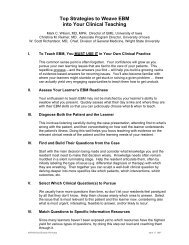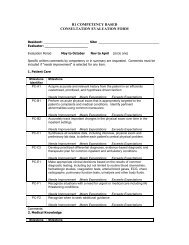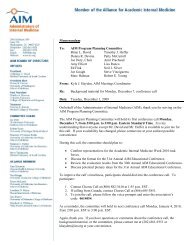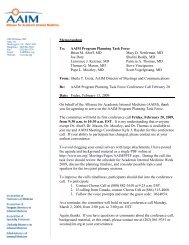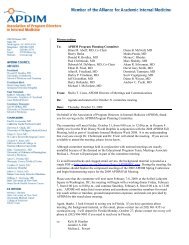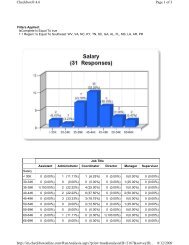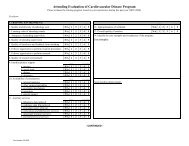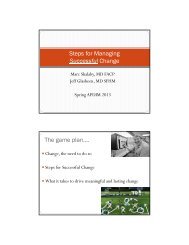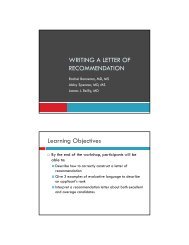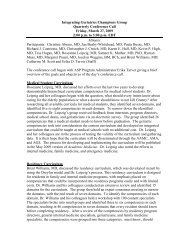Molecular and cellular changes in acute kidney injury
Molecular and cellular changes in acute kidney injury
Molecular and cellular changes in acute kidney injury
You also want an ePaper? Increase the reach of your titles
YUMPU automatically turns print PDFs into web optimized ePapers that Google loves.
Acute Kidney Injury <strong>in</strong> Ag<strong>in</strong>g<br />
The Role of Basel<strong>in</strong>e ROS <strong>and</strong><br />
Inflammation <strong>in</strong> AKI<br />
AGER1 is a determ<strong>in</strong>ant of Basel<strong>in</strong>e<br />
ROS/Inflammation <strong>in</strong> Ag<strong>in</strong>g<br />
AGER1 Controls ROS <strong>and</strong> Inflammation,<br />
thus it may control AKI <strong>in</strong> Toxic Injury, DM<br />
Gary E. Striker, MD<br />
Helen Vlassara, MD<br />
Mount S<strong>in</strong>ai School of Medic<strong>in</strong>e, NY<br />
1
Determ<strong>in</strong>ants of ROS <strong>and</strong><br />
Inflammation <strong>and</strong> AKI <strong>in</strong> Ag<strong>in</strong>g<br />
• The Development of AKI <strong>in</strong> Ag<strong>in</strong>g Patients<br />
with Drug Toxicity or Diabetes Depends on<br />
Pre-Exist<strong>in</strong>g ROS/Inflammation.<br />
• What Determ<strong>in</strong>es Pre-Exist<strong>in</strong>g ROS?<br />
Is it Genes or Environmental Oxidants<br />
• AGER1 Controls the Levels of ROS/Infl<br />
(normally) by controll<strong>in</strong>g oxidants (AGEs).<br />
2
AGEs are one Major Source of Oxidants:<br />
the Level of Oxidants Determ<strong>in</strong>es ROS<br />
HbA1c<br />
Prote<strong>in</strong>s<br />
Lipids<br />
Prote<strong>in</strong><br />
RNA/DNA<br />
+<br />
Glucose<br />
HO<br />
·<br />
-A<br />
RO<br />
·<br />
B<br />
O·<br />
ROS<br />
-C<br />
AGEs<br />
RNS<br />
ROS/Infl<br />
H.Vlassara: Annals of Medic<strong>in</strong>e, 2008<br />
3
Summary (AGEs - ROS)<br />
• AGEs-ROS <strong>in</strong>crease with chronological age, <strong>and</strong><br />
they derive mostly from food.<br />
• Excess AGE-ROS are bound <strong>and</strong> detoxified by<br />
AGER1, <strong>and</strong> are excreted by the <strong>kidney</strong>s.<br />
• AGER1 controls systemic AGE-ROS, <strong>and</strong> may<br />
control the response to AKI <strong>in</strong> ag<strong>in</strong>g after tox<strong>in</strong><br />
exposure <strong>and</strong> <strong>in</strong> diabetes.<br />
4
AGER1 at the Cell Surface Controls<br />
Exposure of Cells to Oxidant AGEs<br />
Extr<strong>in</strong>sic Oxidants (MG, CML)<br />
AGEs<br />
AGE-Restriction<br />
AGER1<br />
EGFR<br />
AGER1<br />
RAGE<br />
p66Shc<br />
p-PKC δ<br />
p-p47 phox<br />
ROS<br />
NAPDH<br />
Cytoplasm<br />
NF-kB p65<br />
p-AKT<br />
p-FOXO<br />
Nucleus<br />
TNFα<br />
Vlassara, PNAS 2006, AmJPhys 2009<br />
5
AGER1 is Present <strong>in</strong> Many Cell Membranes;<br />
In the E.R. it is part of the OST Complex<br />
The OST Complex Plays a Role <strong>in</strong> Prote<strong>in</strong><br />
Secretion, Synthesis, RNA Synthesis <strong>and</strong> the<br />
Unfolded Prote<strong>in</strong> Response (UPR).<br />
6
AGER1 <strong>and</strong> the OST Complex<br />
• Misfolded prote<strong>in</strong>s <strong>in</strong>crease OS <strong>and</strong> turn off<br />
prote<strong>in</strong> <strong>and</strong> RNA synthesis (unfolded prote<strong>in</strong><br />
response, UPR).<br />
• AGER1 may Protect Aga<strong>in</strong>st ROS <strong>and</strong> the UPR.<br />
• AGER1 Deficiency may Promote <strong>and</strong>/or Aggravate<br />
the UPR.<br />
7
AGER1 Levels, Normal Subjects, CKD Patients<br />
800<br />
AGE-R1 mRNA (AU)<br />
700<br />
600<br />
500<br />
400<br />
300<br />
200<br />
100<br />
Normal<br />
CKD, T2D<br />
0<br />
0 0.5 1 1.5 2 2.5 3 3.5 4 4.5 5<br />
sMG (nmol/ml)<br />
AGER1 levels Normally Respond to AGEs<br />
However, AGER1 is Decreased <strong>in</strong> Chronic OS<br />
Vlassara, Uribarri, Striker et al, JCEM, 2009<br />
8
Serum AGEs <strong>and</strong> Renal Function are L<strong>in</strong>ked<br />
eGFR vs. Ag<strong>in</strong>g<br />
Serum CML vs. eGFR<br />
250<br />
200<br />
r = - 0.447<br />
p = 0.0001<br />
60<br />
50<br />
r = - 0.647<br />
p = 0.0001<br />
150<br />
100<br />
40<br />
30<br />
20<br />
50<br />
10<br />
0<br />
20 40 60 80 100<br />
age (years)<br />
0<br />
0 50 100 150 200 250<br />
eGFRCr<br />
Thus, AGE-ROS <strong>and</strong> Renal Function are L<strong>in</strong>ked.<br />
Vlassara, Uribarri, Striker et al, JAGS 2008; ibid JCEM, 2009<br />
9
AGER1 Levels can be Restored <strong>in</strong> T2D Patients<br />
(4wk) by Reduc<strong>in</strong>g the Intake of AGEs<br />
8-iso<br />
TNFα<br />
AGER1<br />
RAGE<br />
VCAM-1<br />
sCML<br />
sMG<br />
-100 -50 0 50 100<br />
% Change<br />
Thus, Reduced AGER1 levels are not due to<br />
an epigenetic change <strong>and</strong> can be normalized<br />
quickly <strong>and</strong> simply.<br />
10<br />
Vlassara, Uribarri, Striker et al, JCEM, 2009
Restoration of AGER1 by Reduced AGE<br />
Intake Restores AGE Excretion (4 mo)<br />
Ur<strong>in</strong>e MG (nmoles/24 hr)<br />
400.00<br />
* p
Effect of Decreased AGER1 After a AGE over-load<br />
A Low AGE Diet Prevents Kidney Disease of Ag<strong>in</strong>g<br />
<strong>and</strong> a S<strong>in</strong>gle Oral AGE (MG-H1) Promotes CKD of<br />
Ag<strong>in</strong>g <strong>in</strong> (24 mo C57BL6 mice)<br />
A. Low AGE Diet B. AGE (MG)-Supplemented Diet<br />
Thus, AGEs cause ROS/Inflammation, Kidney<br />
Disease, <strong>and</strong> Also Lead to CVD, etc.!<br />
12<br />
Zheng, Vlassara, Striker, AmJPath 2009
AKI <strong>and</strong> Basel<strong>in</strong>e ROS<br />
• Basel<strong>in</strong>e Levels of ROS <strong>and</strong> Inflammation<br />
Determ<strong>in</strong>e The Amount <strong>and</strong> Type of Responses<br />
to an Oxidative Stress or Inflammatory Insult<br />
(tox<strong>in</strong>s, metabolic).<br />
• S<strong>in</strong>ce tox<strong>in</strong>s <strong>and</strong> DM Increase the Levels of<br />
ROS/Inflammation, the Subsequent Response<br />
Depends on Basel<strong>in</strong>e Levels.<br />
• Tested us<strong>in</strong>g Tunicamyc<strong>in</strong> to <strong>in</strong>duce ER stress<br />
<strong>and</strong> by Induc<strong>in</strong>g T1D <strong>in</strong> Young (Low ROS) <strong>and</strong><br />
Old (High ROS) Mice.<br />
13
A<br />
Ur<strong>in</strong>ary Album<strong>in</strong><br />
(g/mg.cr)<br />
Diabetic Nephropathy (Y/O)<br />
##<br />
900<br />
700<br />
Old/DN<br />
500<br />
300<br />
100<br />
*<br />
80<br />
60<br />
Y/DN<br />
Old<br />
40<br />
Y<br />
20<br />
0<br />
Before 2 3 4<br />
months after diabetes<br />
B<br />
Ur<strong>in</strong>ary Album<strong>in</strong><br />
(g/mg.cr)<br />
1000<br />
800<br />
600<br />
400<br />
200<br />
0<br />
##<br />
Y/DN Old/DN<br />
Prote<strong>in</strong>uria Increased <strong>in</strong> the High, But NOT <strong>in</strong><br />
those with Low Pre-exist<strong>in</strong>g OS/Inflammation<br />
Renal Lesions <strong>in</strong> DM with Pre-Exist<strong>in</strong>g OS/Infl<br />
14
Nephropathy Only with High OS/Infl<br />
Young<br />
Old<br />
No Diabetic<br />
Kidney<br />
Lesions<br />
Young<br />
Old<br />
Typical<br />
Diabetic<br />
Kidney<br />
Lesions<br />
Severe<br />
Diabetic Micro<br />
Vascular<br />
Lesions<br />
Old<br />
Tubulo<strong>in</strong>terstitial<br />
lesion score<br />
9m 9m/DN 22m 22m/DN<br />
ER stress <strong>and</strong> High OS/Infl<br />
4<br />
3<br />
2<br />
1<br />
0<br />
TID<br />
B<br />
Apoptotic cell/Field<br />
15<br />
10<br />
5<br />
0<br />
Apop<br />
**<br />
9m 9m/DN 22m 22m/DN<br />
15
A<br />
2.0<br />
High Basel<strong>in</strong>e ROS/Inflammation Was<br />
Associated with Endoplasmic Stress (UPR)<br />
**<br />
B<br />
12<br />
##<br />
G<br />
H<br />
GRP78 (xfold)<br />
1.5<br />
1.0<br />
0.5<br />
CHOP (xfold)<br />
8<br />
4<br />
**<br />
C<br />
0<br />
9m 9m/DN 22m 22m/DN<br />
D<br />
0<br />
9m 9m/DN 22m 22m/DN<br />
I<br />
J<br />
L<br />
E<br />
F<br />
0<br />
9 m 9m/DN 22m 22m/DN<br />
ER Stress Data Were Confirmed <strong>in</strong> KO Mice<br />
K<br />
p-PERK sta<strong>in</strong><strong>in</strong>g<br />
<strong>in</strong> cortex (%)<br />
100<br />
80<br />
60<br />
40<br />
20<br />
**<br />
##<br />
p-eIF2 sta<strong>in</strong><strong>in</strong>g<br />
( Relative unit)<br />
50<br />
40<br />
30<br />
20<br />
10<br />
0<br />
**<br />
9 m 9m/DN 22m 22m/DN<br />
#<br />
16
Block<strong>in</strong>g ER Stress Pathways Blocks Apoptosis<br />
<strong>and</strong> Prote<strong>in</strong>uria <strong>in</strong> Old Diabetic Mice<br />
Cell death (%)<br />
100<br />
80<br />
60<br />
**<br />
40<br />
20<br />
0<br />
**<br />
Tuni (g) 0.6 0.8 1.0 1.2<br />
**<br />
**<br />
Wild type<br />
**<br />
Con DN Con DN<br />
Wild type CHOP-/-<br />
CHOP-/-<br />
Ur<strong>in</strong>ary Album<strong>in</strong><br />
(g/mg.creat<strong>in</strong><strong>in</strong>e)<br />
120<br />
100<br />
80<br />
60<br />
40<br />
20<br />
0<br />
High Pre-Exist<strong>in</strong>g OS/Inflammation <strong>and</strong> ER<br />
Stress (<strong>in</strong> Ag<strong>in</strong>g Mice) is Aggravated by a<br />
Superimposed Oxidative Injury (Tuni, Diabetes).<br />
High Pre-exist<strong>in</strong>g OS/Inflammation Increases<br />
Cytok<strong>in</strong>es <strong>and</strong> Vascular Injury <strong>in</strong> Old DM Mice.<br />
17
Summary<br />
• Pre-Exist<strong>in</strong>g Levels of OS <strong>and</strong> Inflammation Determ<strong>in</strong>e<br />
the Amount <strong>and</strong> Type of Response to AKI (due to<br />
Tox<strong>in</strong>s, DN).<br />
• S<strong>in</strong>ce control of OS/Inflammation is critical <strong>in</strong> AKI,<br />
Pre-Exist<strong>in</strong>g OS should be recognized <strong>and</strong> treated<br />
first.<br />
• OS/Inflammation can be Reduced (with drugs <strong>and</strong>/or<br />
Low-AGE Diet).<br />
• Best Option? A Comb<strong>in</strong>ation of Drugs <strong>and</strong> Control of<br />
AGE Intake.<br />
18
So, What Constitutes High AGE Intake?<br />
Heat-Processed Foods .<br />
The Good News: A 50% decrease may be Sufficient!<br />
No Changes <strong>in</strong> Calorie or Nutrient Consumption 19
Future Directions<br />
• Relationship between AGER1 <strong>and</strong> markers of<br />
AKI; first <strong>in</strong> models <strong>and</strong> then <strong>in</strong> ag<strong>in</strong>g patients<br />
exposed to renal tox<strong>in</strong>s <strong>and</strong>/or with diabetes.<br />
• Determ<strong>in</strong>e if reduction of AGER1 after AKI<br />
prevents/ameliorates the development of CKD.<br />
• Determ<strong>in</strong>e if return of AGER1 levels to normal<br />
<strong>in</strong> ag<strong>in</strong>g patients protects reduces OS/Infl <strong>and</strong><br />
<strong>and</strong> AKI <strong>in</strong> ag<strong>in</strong>g patients scheduled for<br />
elective procedures.<br />
• Focus, focus, focus.<br />
20
Mt. S<strong>in</strong>ai School of Medic<strong>in</strong>e Team<br />
Dr HELEN VLASSARA, Director Division of Experimental<br />
Diabetes <strong>and</strong> Ag<strong>in</strong>g Division, Dept. of Geriatrics<br />
Weij<strong>in</strong>g Cai<br />
Cijiang He<br />
Jaime Uribarri<br />
Susan Goodman<br />
Elliot Rayfield<br />
Juan Badimon<br />
Feng Zheng<br />
Sylvan Wallenste<strong>in</strong><br />
Collaborators<br />
Luigi Ferrucci Nat. Inst. Ag<strong>in</strong>g Baltimore, MD<br />
Edward Fisher New York Univ NY,NY<br />
Carl Schulman M.S.SM, U. Miami, Miami, FL<br />
Maria Alevizaki<br />
Athens Med School Greece<br />
Melpomeni Peppa Athens Med School Greece<br />
Theodore Kosch<strong>in</strong>sky Diabetes Research Institute Dusseldorf, GE<br />
Arl<strong>in</strong> Stirban Tub<strong>in</strong>gen U Tub<strong>in</strong>gen, GE<br />
21



